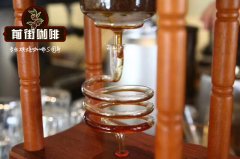Panamanian Cupid farmers select one-water honey treatment containing 30% rose Kaddura Kaduai introduction

Professional coffee knowledge exchange More coffee bean information Please pay attention to coffee workshop (Weixin Official Accounts cafe_style)
Panama, or Panama for short, is the southernmost country in Central America, with a total area of 75517 square kilometers and its capital Panama City. On the isthmus of Panama in Central America, it borders Colombia to the east, the Pacific Ocean to the south, Costa Rica to the west and the Caribbean Sea to the north. The territory is S-shaped connecting North America and South America, and the Panama Canal connects the Atlantic Ocean and the Pacific Ocean from north to south, with the name of "World Bridge".
Panama has an area of 75517 square kilometres, a length of 772 kilometres and a width of between 60 and 177 kilometres. The coastline is 2988 km long and the land boundary is 555 km long. In latitude and longitude, Panama lies between 7° and 10° north latitude and between 77° and 83° west longitude.
The Baru volcano is not only the highest mountain range in Panama, but the sediments produced by early volcanic activity and eruptions bring abundant and very fertile soil, which is rich in nutrients, especially phosphorus and sulfur. When mixed with clay, together with unique climatic patterns, it forms an environment suitable for the growth of high-quality coffee. The dense forest and the large number of species form the overall biodiversity.
The coffee farmers here, about 50 of them in a small cooperative, produce coffee the traditional way in the Borquites-growing it in a near-natural environment. Although the yield is not high, it can maintain a rich ecological environment, and the soil quality can be maintained or even improved.
Natural cultivation methods are not only beneficial to the environment, because coffee fruit grows slowly, so it is easier to grow high-quality and very good flavor coffee beans. The farmers manually harvest the whole berries and send them to the nearby Cafede ELEta S.A. for post-processing, which is about 4 km away from the farm and has a modern laboratory attached for quality control and manual screening.
This coffee consists of three varieties: Guixia, Kadura and Kaduai. It grows in volcanic areas above 1600 degrees above sea level. The treatment plant uses fine honey treatment and traditional washing. Panama's special local microclimate results in abundant rainfall in the region, and the temperature difference between day and night is large. In addition, the volcanic rock soil unique to volcanic areas, as well as careful harvesting and fine processing, make this coffee excellent in terms of body, acidity and tea feel.
Produced by: Volcan Baru
Altitude: 1600-1650m
Breeds: Catuai, Caturra, Geisha 30%
Grade: SHB
Treatment method: washing treatment
Flavor Description: Bergamot, citrus, roasted nuts, sugar cane, flower aromas, similar to white wine taste, Darjeeling black tea touch.
END
Important Notice :
前街咖啡 FrontStreet Coffee has moved to new addredd:
FrontStreet Coffee Address: 315,Donghua East Road,GuangZhou
Tel:020 38364473
- Prev

Introduction to the flavor of Kenyan coffee from the Heart of Africa. How about Kenyan coffee that has been grown for a century?
Professional coffee knowledge exchange more coffee bean information Please follow the coffee workshop (Wechat official account cafe_style) when it comes to coffee in Africa, in addition to Yega and Sidamo in Ethiopia, there is also a place where coffee has to be mentioned in Kenya! Even though neighboring Ethiopia is seen as the birthplace of coffee, Kenya's coffee industry is relatively late.
- Next

Champion Coffee Bean | introduction to the flavor and taste of Ethiopia Aricha anaerobic solarization treatment
Professional coffee knowledge exchange more coffee bean information please follow the coffee workshop (Wechat official account cafe_style) Aricha is Ethiopia famous for its fruity flavor, the whole has a very pleasant sense of juice. Ados has adopted the anaerobic sun treatment method in recent years, which has added more abundant lovely tropical fruit notes, such as guava, jackfruit, fresh carambola, it
Related
- Detailed explanation of Jadeite planting Land in Panamanian Jadeite Manor introduction to the grading system of Jadeite competitive bidding, Red bid, Green bid and Rose Summer
- Story of Coffee planting in Brenka region of Costa Rica Stonehenge Manor anaerobic heavy honey treatment of flavor mouth
- What's on the barrel of Blue Mountain Coffee beans?
- Can American coffee also pull flowers? How to use hot American style to pull out a good-looking pattern?
- Can you make a cold extract with coffee beans? What is the right proportion for cold-extracted coffee formula?
- Indonesian PWN Gold Mandrine Coffee Origin Features Flavor How to Chong? Mandolin coffee is American.
- A brief introduction to the flavor characteristics of Brazilian yellow bourbon coffee beans
- What is the effect of different water quality on the flavor of cold-extracted coffee? What kind of water is best for brewing coffee?
- Why do you think of Rose Summer whenever you mention Panamanian coffee?
- Introduction to the characteristics of authentic blue mountain coffee bean producing areas? What is the CIB Coffee Authority in Jamaica?

